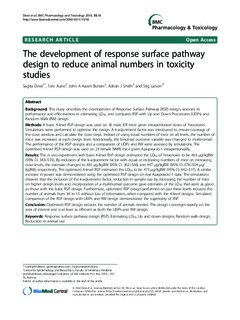| dc.description.abstract | Background
This study describes the development of Response Surface Pathway (RSP) design, assesses its performance and effectiveness in estimating LD50, and compares RSP with Up and Down Procedures (UDPs) and Random Walk (RW) design.
Methods
A basic 4-level RSP design was used on 36 male ICR mice given intraperitoneal doses of Yessotoxin. Simulations were performed to optimise the design. A k-adjustment factor was introduced to ensure coverage of the dose window and calculate the dose steps. Instead of using equal numbers of mice on all levels, the number of mice was increased at each design level. Additionally, the binomial outcome variable was changed to multinomial. The performance of the RSP designs and a comparison of UDPs and RW were assessed by simulations. The optimised 4-level RSP design was used on 24 female NMRI mice given Azaspiracid-1 intraperitoneally.
Results
The in vivo experiment with basic 4-level RSP design estimated the LD50 of Yessotoxin to be 463 μg/kgBW (95% CI: 383–535). By inclusion of the k-adjustment factor with equal or increasing numbers of mice on increasing dose levels, the estimate changed to 481 μg/kgBW (95% CI: 362–566) and 447 μg/kgBW (95% CI: 378–504 μg/kgBW), respectively. The optimised 4-level RSP estimated the LD50 to be 473 μg/kgBW (95% CI: 442–517). A similar increase in power was demonstrated using the optimised RSP design on real Azaspiracid-1 data. The simulations showed that the inclusion of the k-adjustment factor, reduction in sample size by increasing the number of mice on higher design levels and incorporation of a multinomial outcome gave estimates of the LD50 that were as good as those with the basic RSP design. Furthermore, optimised RSP design performed on just three levels reduced the number of animals from 36 to 15 without loss of information, when compared with the 4-level designs. Simulated comparison of the RSP design with UDPs and RW design demonstrated the superiority of RSP.
Conclusion
Optimised RSP design reduces the number of animals needed. The design converges rapidly on the area of interest and is at least as efficient as both the UDPs and RW design. | nb_NO |

